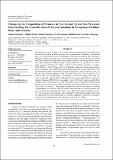| dc.contributor.author | Ochanda, Simon O. | |
| dc.contributor.author | Owuor, Philip O. | |
| dc.contributor.author | Wanyoko, John K. | |
| dc.contributor.author | Kamau, David M. | |
| dc.contributor.author | Faraj, Abdul K. | |
| dc.contributor.author | Onyango, Christine A. | |
| dc.date.accessioned | 2018-06-28T11:53:55Z | |
| dc.date.available | 2018-06-28T11:53:55Z | |
| dc.date.issued | 2017 | |
| dc.identifier.citation | Ochanda, S.O.; Owuor, P.O.; Wanyoko, J.K. Kamau, D.M.; Faraj, A.K.; Onyango, C.A. (2017). Changes in mineral contents of non-aerated green tea processed from seedling tea (Camellia sinensis) due to nitrogenous fertilizer rates and seasons. International Journal of Tea Science, 13 (1&2), 80-93 | en_US |
| dc.identifier.issn | DOI: https://doi.org/10.20425/ ijts.v13i01-02.9987 | |
| dc.identifier.uri | https://repository.maseno.ac.ke/handle/123456789/656 | |
| dc.description.abstract | Soil nutrients are lost to the plant with harvested crop in tea production with most ending up as minerals and contribute to human nutrition upon tea consumption. Production of non-aerated green tea in Kenya has been low. The changes in the mineral profiles of these teas due to nitrogenous fertilizer rates and seasons is not been documented. Several elements were profiled from non-aerated green teas processed from seedling tea grown under varying fertilizer rates of up to 800kg N/ha/year in different seasons. They included N, P, Ca, Mg, Mn, Zn, Cu and Fe which registered 3.32-3.79%, 0.22-0.29 %, 1.47-2.13%, 0.42-0.87%, 0.14-0.38%, 0.11-0.28%, 19.29-41.88ppm, 11.68-25.53ppm and 175.83-206.28ppm respectively with nitrogenous fertilizer rates. The elements were significantly (pd”0.05) higher during the wet and warm, and wet and cold seasons than in the warm and dry, and cold and dry seasons. For the seasons, N, P, K, Ca, Mg, Mn, Zn, Cu and Fe registered 3.19-4.22%, 0.16-0.35%, 0.51-2.10%, 0.42-0.92%, 0.120.44%, 0.13-0.35%, 8.74-84.94ppm, 6.67-84.67ppm and 66.07-363.39ppm respectively. The
values changed with rainfall distribution, although the response patterns differed between individual elements. Inceasing NPKS fertilzer rate caused a rise in N, P and K values especially, from October to June. However, there was a shift in the months of July to September between 400 and 800 kg N/ha/year, in the first year of study. During the second year, the observed shift in year one of the study was revesred. Consequently throughout the year the increments in nutrients corresponded to that of fertilzer rates. The results demonstrate that soil nutrients removed with crop vary with seasons and nitrogenous fertilizer rates. High rate of fertilizer contributed to more N, P and K and other micro-elements such as Mn.and Fe to the finished products. The results also demonstrate that in non-aerated green tea production, application of high rates of nitrogen is necessary to maintain plant nutritional requirements and fresh leaf quality. | en_US |
| dc.description.sponsorship | National Commission for Science, Technology and Innovation (NACOSTI) and Kenya Agricultural and Livestock Organization-Tea Research Institute (KALRO-TRI) | en_US |
| dc.publisher | International Journal of Tea Science Vol 13, No. 1&2 (2017) : 80-93 | en_US |
| dc.relation.ispartofseries | ;DOI: https://doi.org/10.20425/ ijts.v13i01-02.9987 | |
| dc.subject | Fertilizer, macro and micronutrients, season, green tea, nutritional value | en_US |
| dc.title | Changes in the Composition of Elements in Non-Aerated Green Teas Processed from Seedling Tea (Camellia sinensis) Due to Variations in Nitrogenous Fertilizer Rates and Seasons. | en_US |
| dc.type | Article | en_US |

